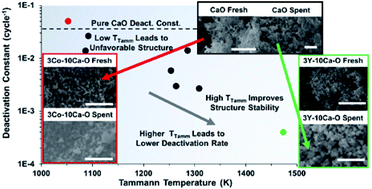Impacts of metal oxide additives on the capacity and stability of calcium oxide based materials for the reactive sorption of CO2†
Abstract
Several metal additives (Al, Co, Cr, Er, Ga, In, La, Li, Mg, Nd, Y, and Zn) at nominal 3 : 10 (M : Ca) ratios were investigated for their ability to stabilize high capacity calcium oxide nanofibers over repeated carbonation–regeneration cycles. Samples containing Mg, Y, Nd, La, and Er additives had maximum sorption capacities from 0.40–0.60 gCO2 gsorbent−1, compared to 0.79 gCO2 gsorbent−1 for CaO. Y, Al, Er, and Nd were most effective for improving the stability of CaO, each had first order deactivation constants that were at least one order of magnitude smaller compared to CaO. Post-carbonation characterization revealed that particle agglomeration and structure degradation were the primary reasons for loss in capacity over repeated carbonation–regeneration cycles. Metal additives with high Tammann temperatures of the corresponding metal oxide mitigated structure degradation, leading to improved cyclic stability compared to pure CaO. Additionally, mixed oxide formation had no effect on stability albeit a deleterious effect on sorbent capacity.



 Please wait while we load your content...
Please wait while we load your content...